|
Just beyond the main exposition grounds, to the west of the music concourse and the Palace of Fine Arts, stretched the Avenue of Nations. A walk along this avenue and down the many streets which branched off allowed a visitor to take a small trip around the world. It was here that the many Foreign Pavilions were erected. Thirty one foreign countries participated in the fair but only twenty two countries built pavilions: Japan, Canada, Denmark, France, Belgium, Guatemala, Honduras, Norway, Panama, Greece, Australia, New Zealand, Cuba, Portugal, Italy, Siam, Turkey, Netherlands, Argentina, China, Bolivia, and Sweden. All but one exhibited their finest art, history, commerce, science, architecture and agriculture within and without. Sadly, the Panama Pavilion served as scenery only. Aside from the dedication on July 30th, once erected, it remained empty and shut for the duration of the expo. Panama began plans to host their own exposition while preparing for the 1915 world’s fair. They dedicated all their energy towards this end and supplied no exhibits to furnish their pavilion. 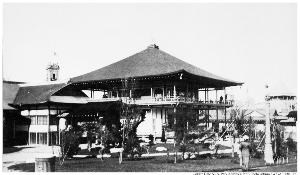
Japanese Pavilion Dedicated-February 24 The first foreign pavilion on the Avenue of Nations was that of Japan. The Japanese Pavilion spanned 3 acres. It consisted of two tea houses and expansive gardens. The garden was decorated with running streams, rocky outcrops, pagodas, lanterns and Buddha statues. There was also an impressive replica of the Shrines at Nikko, fifteenth century temple dedicated to the Shogun Iyeyasu. Japan took advantage of the enormous palaces to showcase their various contributions to the world. They occupied the greatest space by any foreign nation. 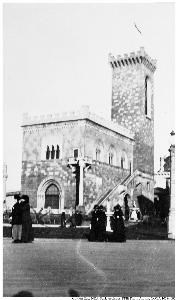
Italian Pavilion Dedicated-April 24 The Italian Pavilion was a pavilion in name only. The Italian designers used the whole of the space provided to construct several buildings. Each building represented the various styles of architecture throughout Italy’s history. These buildings surrounded a court which contained fountains, art and flowers. Inside the buildings, Italy displayed many examples of its artistry: sculpture, painting sand needle work, to name a few. They also exhibited their many advances in education, government and techniques of colonization. The 7.0 Avezzano earthquake of January that year killed 30,000 people. However, this tragedy did not hinder the participation of the country. Even after being pulled into the Great War during the exposition year, the Italian Pavilion and its delegate continued on. 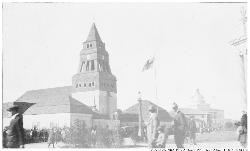
Norway Building Dedicated-February 26 Norway’s Commissioner General gave a speech at their dedication ceremony. He argued it was not just for the many financial benefits associated with displaying Norway’s many exports to a global audience which spurred their participation in the expo stating, “For ninety years Norway has been sending her sons and daughters-pouring a steady stream of her best blood-into this country, until the Norwegians here to-day in number equal those in the home country.” Norwegian music was featured throughout and the national hymn “Ja Vi Elsker Dette Landet” was performed. New Zealand Pavilion Dedicated-March 3 New Zealand had committed to participate nearly as soon as invited, since New Zealand had a long relationship with San Francisco as a shipping ally. Though allotted $75,000 for their participation, their participation in the escalating war resulted in a decrease of 75% of the planned exhibits. There were Maori tribal dance performances at the dedication performed by some 28 men and women. At the dedication, the High Commissioner of New Zealand spoke of his people’s satisfaction at their appearance in the expo and concluded his speech with some words spoken in the Maori tongue 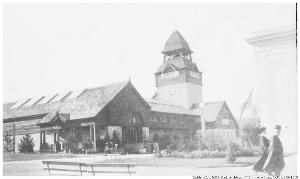
Swedish Pavilion Dedicated-March 2 At the very westerly end of the foreign pavilions rose the bell tower of the Swedish Pavilion. Occupying some twenty five thousand square feet, it was a joint effort between a Swedish architect Ferdinand Boberg, David Yrden and San Francisco architect August Nordin. Upon entry of the pavilion, the visitor was presented with a hall full of portraits of their most famous citizens. They showcased their steel production methods and the many and varied uses for it. They also displayed art, miniature replicas of their ships and locomotives, the Dalen light-house light(which was used along the Pacific coast and along the Panama Canal), illustrations of Swedish gymnastics, advances in hydroelectric energy and turbine generators. France Pavilion Dedicated-April 9 Following the French Revolution, the palace of the Prince De Salm was sold to Napoleon. It was here that the Order of the Legion of Honor would make its home. This building served as the model for the French Pavilion and later as the inspiration for The Legion of Honor in San Francisco. As visitors approached the pavilion, they would pass by colonnades and Rodin’s “Thinker”. The pavilion was filled with French relics, tapestries and other works of art. They also exhibit their education system, subway and street lighting methods. The French Pavilion was also the Belgium Pavilion. Due to the war, Belgium was unable to contribute a pavilion nor furnish one with any exhibits from their soil. France lent Belgium a space in their own pavilion and exhibits were brought from various locations to fill it. France covered all the financial costs of Belgium’s involvement. 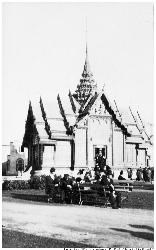
Siam Pavilion The Siam Pavilion was tardy to the expo and thus did not receive a dedication ceremony. The pavilion required the approval of the King of Siam. There for, it was assembled in gull in Siam where he could inspect it. Once approved, it was disassembled and shipped to the exposition arriving in March of the year. Inside the pavilion, Siam displayed the many aspects of life in the country. Their exhibits included: rice, education, timber, tobacco, photos of its cities and towns, and art carved in ivory, among others. A
single person could have spent 24 hours a day every day the expo was open and
still not seen it all... Visit the Exposition
Palaces where the world
showcased their very best Head west of the main exposition grounds to visit the State
Buildings Take a tour of the world as you walk along the Avenue of Nations
and view the Foreign
Pavilions The Presidio has a long military history. See how the Military's
Role shaped the expo. Visit the most sensational sixty five acres at the exposition
along The
"Joy" Zone Aviators, athletes and drivers competed during the year of the
exposition in many types of Sports
and Athletics For More Information: To see more photos and maps, please visit the Panama-Pacific International Exhibition home page. To learn more about the events leading up to the fair, visit Prologue to the Panama-Pacific International Exhibition. To learn about the legacy of the Panama-Pacific International Exhibition and its impact on San Francisco, please visit The Legacy of the Panama-Pacific International Exhibition. |
Last updated: February 28, 2015
